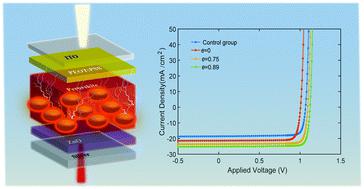当前位置:
X-MOL 学术
›
Phys. Chem. Chem. Phys.
›
论文详情
Our official English website, www.x-mol.net, welcomes your feedback! (Note: you will need to create a separate account there.)
Optical-electrical-thermal optimization of plasmon-enhanced perovskite solar cells.
Physical Chemistry Chemical Physics ( IF 3.3 ) Pub Date : 2020-06-25 , DOI: 10.1039/d0cp02220a Hao Ren 1 , Xingang Ren , Kaikun Niu , Siliang Wang , Zhixiang Huang , Xianliang Wu
Physical Chemistry Chemical Physics ( IF 3.3 ) Pub Date : 2020-06-25 , DOI: 10.1039/d0cp02220a Hao Ren 1 , Xingang Ren , Kaikun Niu , Siliang Wang , Zhixiang Huang , Xianliang Wu
Affiliation

|
Metal nanoparticles associated with local surface plasmon (LSP) resonance, i.e. highly confined electric field and large scattering cross-sections (σ), have been widely used to enhance the light-harvesting of solar cells toward high optoelectronic performance. However, the metal nanoparticles embedded into the solar cells suffer from parasitic ohmic loss that subsequently causes the local temperature to rise, which, in turn, reduces the photoelectric conversion efficiency and stability of solar cells. Previous studies on plasmon-enhanced solar cells have rarely considered the negative effects of metal nanoparticles’ ohmic losses and temperature rise on solar cell performance optimization. Therefore, it is of great interest to alleviate the ohmic loss and temperature rise that are critical for high-performance solar cells. Herein, we propose a model to comprehensively study and optimize the performance of plasmon-enhanced perovskite solar cells (PSCs) from simultaneous optical-electrical-thermal aspects. First, the optical simulation results indicated that the geometric tuning of metal nanoparticles can make full use of the plasmonic effect and significantly improve PSCs’ light absorption. The analysis showed that the embedded nanoparticles with optimal geometry in PSC devices can significantly increase the optical absorption by 17% (41%) compared to non-optimal nanostructures (devices without nanoparticles). Then, we explored the influence of the temperature-dependent carrier mobility on PSC performance from the coupled electrical and thermal studies. Our results indicated that the optimization of the geometrical parameters of metal nanoparticles can minimize energy dissipation, thereby redusing the heat loss and then lowering the local cell temperature. Interestingly, PSCs’ electrical properties such as carrier transportation significantly improved. Consequently, the PSC performance improved with increment in the short-circuit current by 23% and the power conversion efficiency by 38%.
中文翻译:

等离子体增强钙钛矿太阳能电池的光电热优化。
与局部表面等离子体激元(LSP)共振相关的金属纳米颗粒,即高度受限的电场和较大的散射截面(σ)已被广泛用于增强太阳能电池的光捕获性能,以实现高光电性能。然而,嵌入太阳能电池中的金属纳米颗粒遭受寄生欧姆损失,其随后导致局部温度升高,这继而降低了太阳能电池的光电转换效率和稳定性。先前对等离激元增强型太阳能电池的研究很少考虑金属纳米颗粒的欧姆损耗和温度升高对太阳能电池性能优化的负面影响。因此,减轻对高性能太阳能电池至关重要的欧姆损耗和温度升高非常重要。在这里 我们提出了一个模型,可以从光电热同时方面全面研究和优化等离子体增强的钙钛矿太阳能电池(PSC)的性能。首先,光学仿真结果表明,金属纳米粒子的几何调谐可以充分利用等离子体效应,显着提高PSC的光吸收率。分析表明,与非最佳纳米结构(无纳米颗粒的器件)相比,PSC器件中具有最佳几何形状的嵌入式纳米颗粒可将光吸收显着提高17%(41%)。然后,我们从耦合的电学和热学研究中探索了温度依赖性载流子迁移率对PSC性能的影响。我们的结果表明,优化金属纳米粒子的几何参数可以使能量耗散最小化,从而减少热量损失,然后降低局部电池温度。有趣的是,PSC的电性能(例如载流子运输)得到了显着改善。因此,随着短路电流增加23%,功率转换效率增加38%,PSC性能得以提高。
更新日期:2020-08-05
中文翻译:

等离子体增强钙钛矿太阳能电池的光电热优化。
与局部表面等离子体激元(LSP)共振相关的金属纳米颗粒,即高度受限的电场和较大的散射截面(σ)已被广泛用于增强太阳能电池的光捕获性能,以实现高光电性能。然而,嵌入太阳能电池中的金属纳米颗粒遭受寄生欧姆损失,其随后导致局部温度升高,这继而降低了太阳能电池的光电转换效率和稳定性。先前对等离激元增强型太阳能电池的研究很少考虑金属纳米颗粒的欧姆损耗和温度升高对太阳能电池性能优化的负面影响。因此,减轻对高性能太阳能电池至关重要的欧姆损耗和温度升高非常重要。在这里 我们提出了一个模型,可以从光电热同时方面全面研究和优化等离子体增强的钙钛矿太阳能电池(PSC)的性能。首先,光学仿真结果表明,金属纳米粒子的几何调谐可以充分利用等离子体效应,显着提高PSC的光吸收率。分析表明,与非最佳纳米结构(无纳米颗粒的器件)相比,PSC器件中具有最佳几何形状的嵌入式纳米颗粒可将光吸收显着提高17%(41%)。然后,我们从耦合的电学和热学研究中探索了温度依赖性载流子迁移率对PSC性能的影响。我们的结果表明,优化金属纳米粒子的几何参数可以使能量耗散最小化,从而减少热量损失,然后降低局部电池温度。有趣的是,PSC的电性能(例如载流子运输)得到了显着改善。因此,随着短路电流增加23%,功率转换效率增加38%,PSC性能得以提高。

























 京公网安备 11010802027423号
京公网安备 11010802027423号